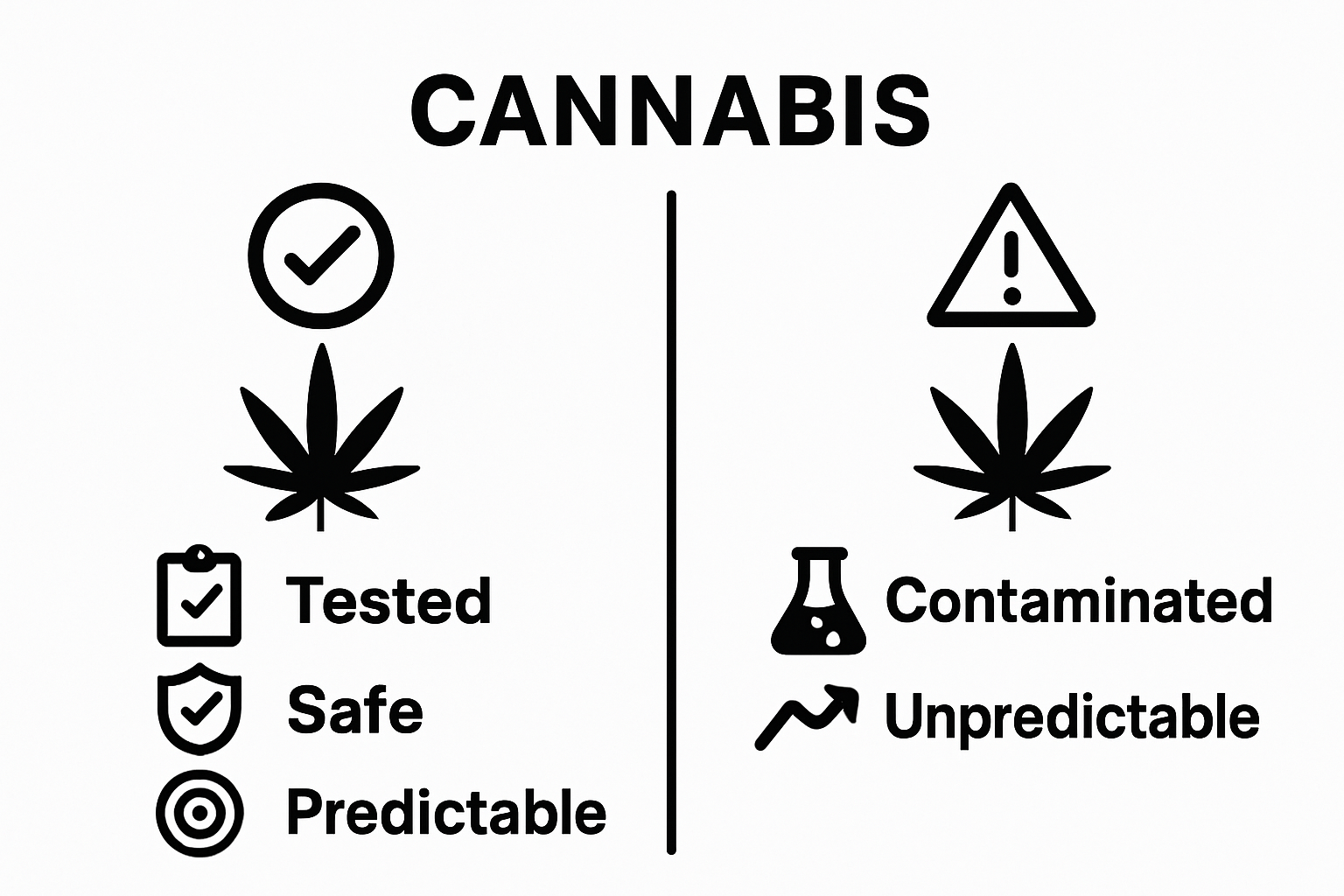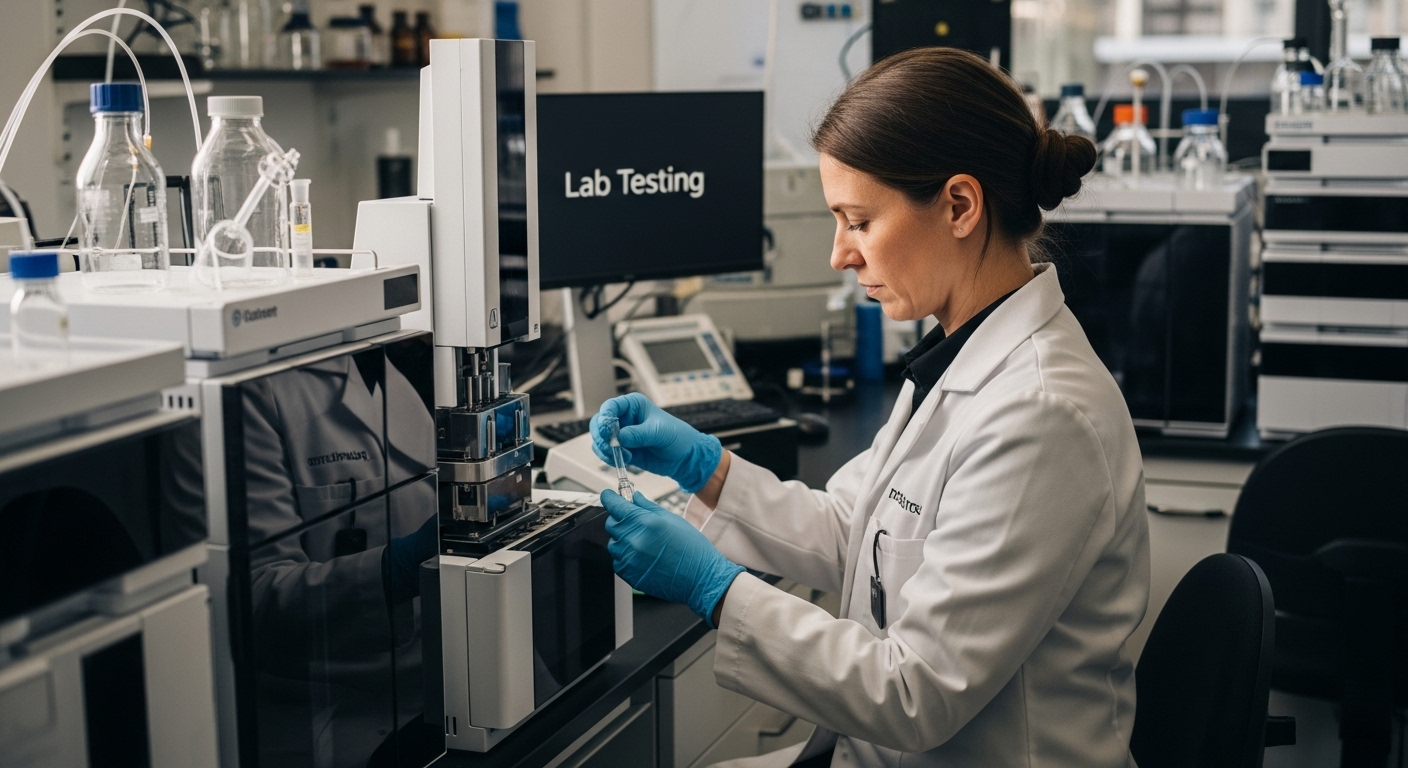Blog
Understanding Why Cannabis Quality Matters for Users
Most people judge cannabis quality by just looking at the buds. Some even rely on smell or color alone. But a single lab test can reveal that over 30 percent of products on dispensary shelves fail strict contamination or potency checks, completely flipping what users expect. True cannabis quality is a whole science that goes deeper than the surface and unpacks surprising ways it can affect both your health and experience.
Table of Contents
- What Is Cannabis Quality And How Is It Measured?
- Why Does The Quality Of Cannabis Impact Effects And Safety?
- How Terpenes And Cannabinoids Determine Quality
- The Role Of Cultivation Practices In Cannabis Quality
- Understanding Lab Testing And Quality Certifications
Quick Summary
| Takeaway | Explanation |
|---|---|
| Understand cannabis chemical profiles | Chemical analysis reveals crucial information about THC, CBD, and terpenes to assess quality. |
| Prioritize contamination testing | Rigorous screening identifies harmful substances like pesticides and heavy metals that can affect health. |
| Recognize the importance of terpenes | Terpene profiles play a significant role in creating unique flavors and therapeutic effects in cannabis. |
| Emphasize cultivation practices | Proper environmental management and organic methods greatly influence cannabis quality and safety. |
| Utilize lab testing for product verification | Lab certifications ensure safety and potency, providing consumers with reliable information on cannabis products. |
What is Cannabis Quality and How is it Measured?
Cannabis quality represents a comprehensive evaluation of the plant’s overall characteristics, chemical composition, and potential effectiveness for users. Understanding cannabis quality goes beyond simple visual assessment, involving sophisticated scientific analysis and precise measurement techniques.
Chemical Composition Analysis
Quality measurement starts with detailed chemical profiling. Scientific research from the National Center for Biotechnology Information demonstrates that cannabis quality fundamentally depends on its cannabinoid and terpene content. Key factors include:
- Precise THC and CBD percentages
- Specific terpene profile
- Cannabinoid ratio and concentration
- Absence of harmful contaminants
Professional laboratories utilize advanced chromatography and spectrometry techniques to determine these intricate chemical signatures. These methods provide a granular understanding of the cannabis product’s potential effects, potency, and safety.
Physical and Sensory Evaluation
Beyond chemical analysis, cannabis quality assessment includes physical characteristics. Experts examine several critical visual and tactile indicators:
- Bud structure and density
- Color consistency and vibrancy
- Trichome coverage and appearance
- Moisture content and trimming quality
Experienced cultivators and lab technicians can quickly identify premium cannabis by understanding these nuanced physical markers. The goal is to ensure users receive a product that meets stringent quality standards.
For those interested in diving deeper into product verification, check out our guide on cannabis product authenticity.
Contamination and Safety Screening
A critical aspect of cannabis quality assessment involves comprehensive safety screening. This process identifies potential biological or chemical contaminants that could compromise user health. Screening typically includes testing for:
- Pesticide residues
- Heavy metal concentrations
- Microbial organisms
- Potential mold or mildew
These rigorous testing protocols ensure that consumers receive cannabis products that are not just potent, but also safe for consumption. By maintaining such high standards, the industry protects user health and builds trust in cannabis products.
Why Does the Quality of Cannabis Impact Effects and Safety?
Cannabis quality directly influences both the therapeutic potential and potential risks associated with consumption. Understanding these connections is crucial for responsible and informed use, as the chemical composition and purity of cannabis can significantly alter user experiences and health outcomes.

Cannabinoid Complexity and User Response
Research from the National Institutes of Health highlights that inconsistent cannabinoid content can lead to unpredictable physiological responses. The intricate interactions between different cannabinoids determine the overall effect on the human body. Key factors include:
- Precise THC to CBD ratios
- Individual metabolic differences
- Potential therapeutic or adverse reactions
- Variability in personal endocannabinoid system sensitivity
Low-quality cannabis with unverified cannabinoid profiles can trigger unexpected psychological or physical responses, potentially exacerbating underlying health conditions.
Contamination Risks and Health Implications
Poor quality cannabis introduces significant health hazards. Contaminants can transform what should be a therapeutic experience into a dangerous encounter. Critical contamination risks include:
- Pesticide residue accumulation
- Heavy metal presence
- Microbial infection potential
- Mold and fungal growth
These contaminants can cause serious health complications, ranging from respiratory issues to potential long-term cellular damage. Professional testing becomes essential in mitigating these risks.
Below is a table summarizing the major contamination risks in cannabis products and their potential health impacts, as discussed in the article.
| Contaminant | Potential Source | Health Risks |
|---|---|---|
| Pesticide residues | Non-organic cultivation | Respiratory issues, cellular damage |
| Heavy metals | Soil, water contamination | Long-term toxicity, organ damage |
| Microbial organisms | Poor cultivation/processing | Infection, allergic reactions |
| Mold and mildew | Inadequate storage/drying | Lung irritation, respiratory illness |
Potency and Dosage Precision
Quality directly correlates with the ability to control dosage and understand potential effects. High-quality cannabis provides consistent and predictable experiences, allowing users to make informed consumption decisions.
Learn more about our comprehensive purity testing protocols to understand how professional verification protects consumer health. Precise cannabinoid measurement enables users to select products matching their specific therapeutic or recreational needs, reducing the likelihood of overconsumption or unexpected reactions.
How Terpenes and Cannabinoids Determine Quality
Cannabis quality extends far beyond basic visual assessments, with terpenes and cannabinoids serving as the core determinants of a product’s overall effectiveness, therapeutic potential, and sensory experience. These molecular compounds create a complex biochemical landscape that defines the unique characteristics of each cannabis strain.
The Biochemical Symphony of Cannabis
Scientific research from the National Institutes of Health reveals that the interaction between cannabinoids and terpenes creates a sophisticated biochemical mechanism known as the entourage effect. This intricate relationship determines the cannabis product’s ultimate quality through several critical components:
- Total cannabinoid concentration
- Specific cannabinoid ratios
- Diversity of terpene profiles
- Molecular interaction potential
Understanding these interactions allows consumers and researchers to predict and evaluate the potential therapeutic and recreational outcomes of different cannabis strains.
Terpene Complexity and Sensory Characteristics
Terpenes represent the aromatic compounds responsible for cannabis’s distinctive flavors and potential therapeutic properties. Each terpene contributes unique characteristics that significantly influence product quality. Different terpene profiles can produce dramatically different sensory and physiological experiences:
- Myrcene: Produces relaxing effects
- Limonene: Associated with mood elevation
- Pinene: Potential cognitive enhancement
- Linalool: Potential anxiety reduction
Explore our comprehensive guide to understanding terpene types to gain deeper insights into these remarkable compounds.
Cannabinoid Precision and Therapeutic Potential
The precise combination and concentration of cannabinoids like THC and CBD fundamentally determine a cannabis product’s quality and potential applications. High-quality cannabis demonstrates consistent, well-balanced cannabinoid profiles that provide predictable and reliable experiences. These molecular compositions directly impact the product’s effectiveness for various therapeutic or recreational purposes, making careful analysis and testing essential for ensuring superior cannabis quality.
The Role of Cultivation Practices in Cannabis Quality
Cultivation practices serve as the foundational blueprint for cannabis quality, dramatically influencing the plant’s chemical composition, potency, and overall therapeutic potential. Every decision made during the growing process directly impacts the final product’s safety, effectiveness, and user experience.
Environmental Control and Genetic Selection
Agricultural research from leading botanical journals demonstrates that precise environmental management is crucial in producing high-quality cannabis. Critical factors in cultivation quality include:
- Controlled light spectrum and intensity
- Precise temperature and humidity regulation
- Genetic strain selection and preservation
- Soil composition and nutrient management
Professional cultivators understand that cannabis plants are extraordinarily sensitive to their growing environment, with even minor fluctuations potentially compromising chemical stability and cannabinoid production.
Organic Cultivation and Contaminant Prevention
Organic cultivation practices represent a critical strategy in ensuring cannabis quality and safety. By minimizing synthetic interventions, cultivators can reduce the risk of harmful chemical residues. Key organic cultivation considerations include:
- Elimination of synthetic pesticides
- Natural pest management techniques
- Comprehensive soil health monitoring
- Sustainable water and nutrient management
The goal is creating a pristine growing environment that allows cannabis plants to develop their most authentic and potent chemical profiles without external contamination.
Harvesting and Post-Harvest Processing
The final stages of cultivation are equally important in determining cannabis quality. Precise harvesting techniques and meticulous post-harvest processing can preserve or diminish the plant’s therapeutic potential. Factors like harvest timing, drying conditions, and storage protocols directly influence the final product’s chemical integrity.
Learn more about our commitment to cannabis quality verification to understand how professional cultivation translates into superior consumer experiences. Professional cultivators recognize that quality is not just about growing cannabis, but about creating a comprehensive ecosystem that nurtures the plant’s most beneficial characteristics.
Understanding Lab Testing and Quality Certifications
Lab testing and quality certifications represent the scientific backbone of cannabis product verification, providing consumers with objective evidence of safety, potency, and consistency. These rigorous evaluation processes transform cannabis from a raw agricultural product into a precisely measured and validated consumer good.
Comprehensive Analytical Testing Protocols
Research from the Journal of Analytical Toxicology highlights the intricate nature of cannabis laboratory testing. Comprehensive testing encompasses multiple sophisticated analytical techniques designed to evaluate product integrity across several critical dimensions:
- Cannabinoid profile quantification
- Terpene composition analysis
- Contaminant screening
- Microbiological examination
- Residual solvent detection
These multifaceted tests provide a holistic view of cannabis product quality, ensuring that consumers receive a scientifically validated substance with predictable characteristics.
The following table organizes the key laboratory testing protocols used to guarantee cannabis quality and safety as outlined in the article.
| Testing Protocol | Purpose |
|---|---|
| Cannabinoid profile quantification | Verify THC, CBD, and other cannabinoids |
| Terpene composition analysis | Assess aroma, flavor, and therapeutic value |
| Contaminant screening | Detect pesticides, heavy metals, solvents |
| Microbiological examination | Identify microbial and fungal contamination |
| Residual solvent detection | Ensure absence of harmful processing chemicals |

Certification Standards and Regulatory Compliance
Quality certifications serve as crucial indicators of a cannabis product’s adherence to stringent industry standards. Professional laboratories utilize standardized testing methodologies that align with regional regulatory requirements, guaranteeing consistent and reliable product evaluations:
- ISO 17025 accreditation
- State-mandated testing protocols
- Third-party verification processes
- Comprehensive documentation of testing procedures
Certifications act as a consumer protection mechanism, offering transparency and accountability in an industry that requires meticulous quality control.
Interpreting Lab Test Results
Understanding lab test results requires specialized knowledge of cannabis biochemistry and analytical techniques. These documents provide detailed insights into a product’s molecular composition, potential effects, and safety profile.
Explore our guide to understanding cannabis product authentication to gain deeper insights into interpreting these critical scientific documents. Professional consumers increasingly recognize lab test results as the most reliable indicator of cannabis product quality, moving beyond subjective assessments toward scientific verification.
Experience the Confidence of Verified Cannabis Quality
Struggling to trust the true quality of your cannabis? If you have ever worried about hidden contaminants, inconsistent potency, or unpredictable effects, you know how important real product verification is. This article explained how precise cannabinoid and terpene profiles, as well as purity testing and certified authenticity, can make all the difference for your health and experience. At Puff Laco, you can leave doubts behind. Every vape, edible, and pre-roll on our site undergoes thorough lab analysis to check for pesticides, heavy metals, and verify exact formulas, matching the highest standards discussed in our cannabis purity testing facts. That means what you see on the label actually matches what is in your product.
.png)
Ready to see the difference superior quality delivers? Discover our wide range of full spectrum extracts, live resins, and flavor-specific gummies. Explore all premium options directly at Puff Laco. If you want to go deeper into safe sourcing and true product authenticity, visit our guide on cannabis product authenticity. Trust your next cannabis experience to a retailer committed to scientific transparency and fast shipping. Shop today so you never have to guess about quality again.
Frequently Asked Questions
What factors determine cannabis quality?
Cannabis quality is determined by its chemical composition, including cannabinoid and terpene content, as well as physical characteristics like bud structure and moisture content. Comprehensive laboratory testing ensures the absence of harmful contaminants and verifies potency.
How do cannabinoids and terpenes affect the user experience?
Cannabinoids like THC and CBD and terpenes contribute to cannabis’s overall effectiveness and sensory experience. The unique combination of these compounds can influence therapeutic potential, recreational effects, and how a user feels after consumption.
Why is lab testing important for cannabis products?
Lab testing is crucial as it provides objective evidence of cannabis product quality, including cannabinoid profiles, potency, and potential contaminants. It ensures consumers receive safe and effective products, promoting transparency and accountability in the industry.
What are the risks of consuming low-quality cannabis?
Consuming low-quality cannabis can pose significant health risks, including exposure to harmful contaminants like pesticides and heavy metals. It may also lead to inconsistent effects or unexpected psychological responses due to unverified cannabinoid profiles.
Recommended
- 7 Essential Cannabis Purity Testing Facts You Need to Know – PUFF LA
- Understanding Cannabis Product Authenticity Explained – PUFF LA
- Understanding Why Cannabis Authenticity Matters – PUFF LA
- Understanding Cannabis Purity Analysis Explained – PUFF LA

